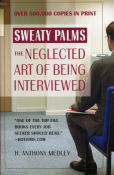| What REALLY goes on in a job interview? Find out in the new revision of "Sweaty Palms: The Neglected Art of Being Interviewed" (Warner Books) by Tony Medley, updated for the world of the Internet . Over 500,000 copies in print and the only book on the job interview written by an experienced interviewer, one who has conducted thousands of interviews. This is the truth, not the ivory tower speculations of those who write but have no actual experience. "One of the top five books every job seeker should read," says Hotjobs.com. | |
| Everyone’s Hero (7/10) by Tony Medley Though I’ve belted you and flayed you, by the living god that made you, if you can watch a feature length cartoon without falling asleep, you’re a better man than I am, Gunga Din! That’s what I did today. I went to this film not knowing it was a cartoon (OK, to be politically correct, it’s animated). It’s about a little cartoon character who has to find Babe Ruth’s stolen bat (Whoopi Goldberg) because his father has been fired from his Yankee job because it’s been stolen on his watch. Helped by a talking baseball (Rob Reiner, in a brilliant bit of casting), he goes through the trials of Hercules to find the bat, recover it, and get it back to the Babe in time for the World Series game. As a feature length cartoon goes, this is pretty good. It is poignant because the Executive Producers are Christopher Reeve and his wife, Dana. I think Dana should be canonized into sainthood before anyone else because of how she cared for Christopher. I’m convinced that what she had to go through is what killed her and left her son without parents. They apparently really had a strong feeling for this movie because it’s about not giving up, a concept for which they should be the poster children. The reason I loathed Clint Eastwood’s “Million Dollar Baby” so much is that I thought it was an affront to people like the Reeves who persevered and tried to survive in the face of almost hopeless odds. While Eastwood’s film extolled giving up, Christopher and Dana kept going and gave the world something to admire. This might be my last chance, so I reiterate what I felt at the time as reflected in my review, A Pox On Million Dollar Baby and what it stands for! I wish the Reeves had hired me as a technical adviser, though, because there are some needless historical inaccuracies. Because this is a cartoon, it should have been dead on with a little good research. The Yankee Stadium they show is not the Yankee Stadium in which the Babe played. It is the renovated Stadium, circa 1990, with its green outfield fence. The babe played in a stadium that had a chain link type railing, only four feet high, in right and left fields. The big game in Chicago has to be against the Cubs because it’s the World Series. The only World Series that Babe’s Yankees played against the Cubs was 1932 (the Yankees swept in four, after the Babe’s famous “called shot” homerun in the third game). But that would mean that the game was played in Wrigley Field. The stadium in this film doesn’t resemble Chicago’s Wrigley Field in the slightest. Since this is a cartoon, why not be accurate? Another minor thing is that Babe’s manager is clearly Joe Torre. Joe Torre wasn’t even born when the Babe was playing. In 1932 the Yankee manager was Joe McCarthy. There are other inaccuracies, like blacks apparently playing in organized baseball (there is a black team called “Cincinnati.” It is shown as being all black. There was not a Cincinnati team in the Negro Leagues as far as I can remember, and there were no black baseball players in Organized Baseball between 1888 and 1946). This of course, didn’t happen until Jackie Robinson broke the color line with the Brooklyn Dodgers in 1947. Well, this is a fable, so facts are irrelevant, and it’s well done. The inaccuracies don’t hurt it at all unless you are a baseball purist, as am I. If you can stomach feature length animation, this is a good one, and it spits in Million Dollar Baby’s eye, which is a good thing. September 7, 2006
|
|
|
|
|
